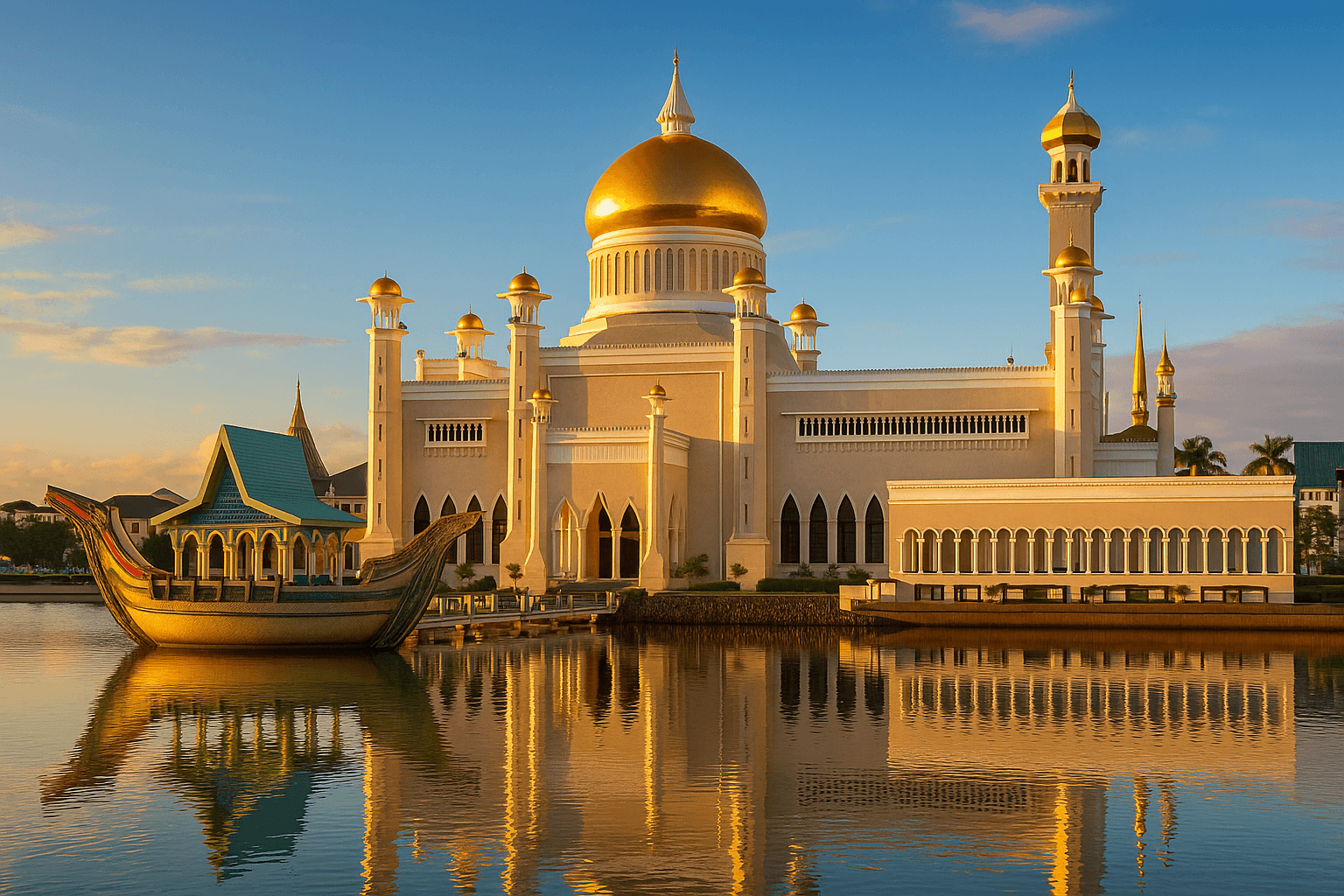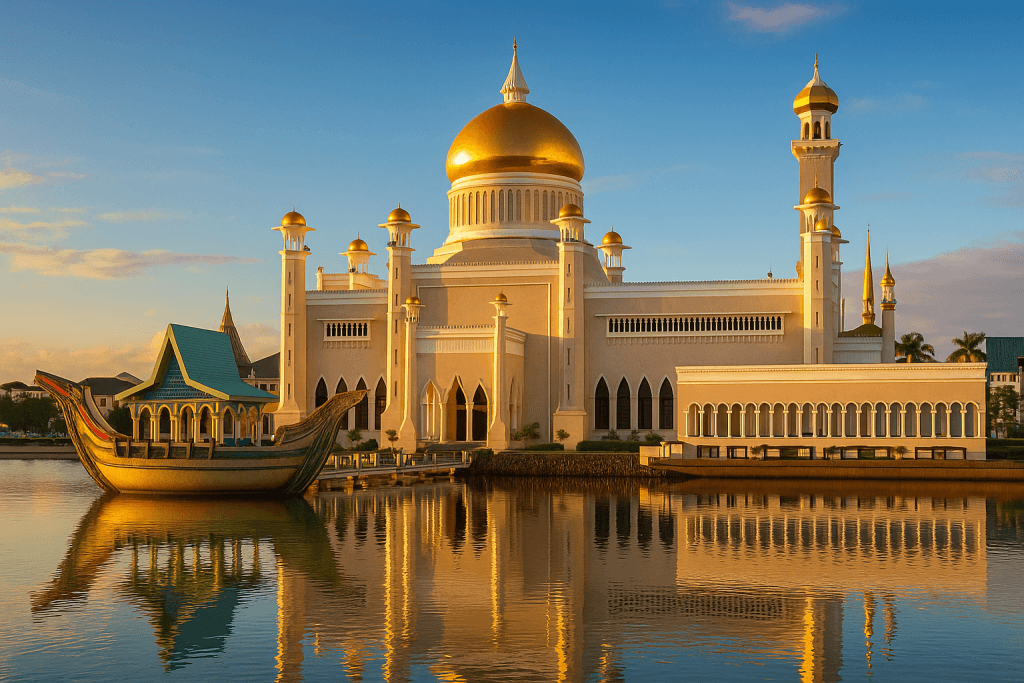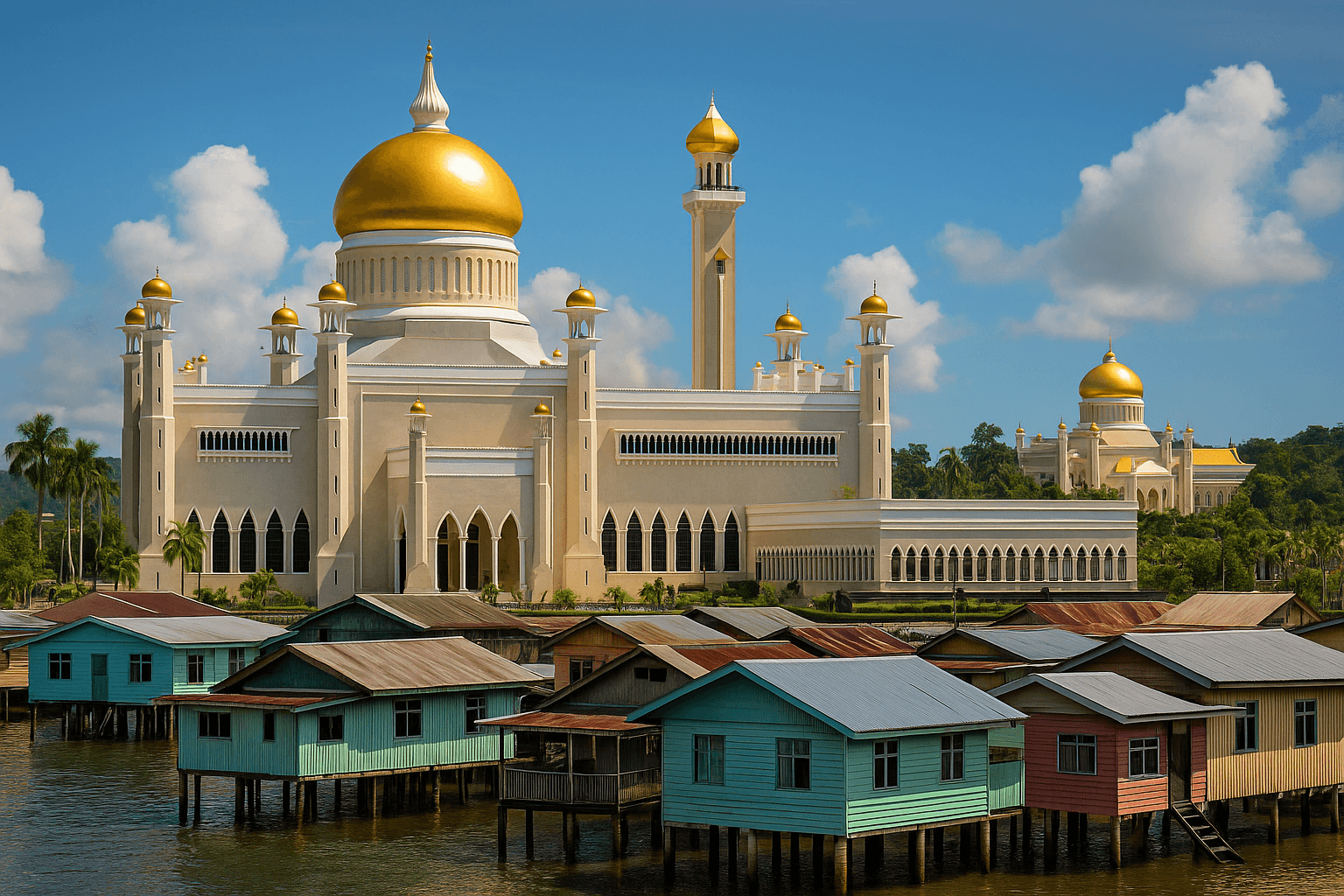Among the magnificent landmarks of Southeast Asia, few hold as much cultural, architectural, and spiritual significance as the Omar Ali Saifuddien Mosque – The Golden Icon of Brunei. Rising gracefully in the capital city of Bandar Seri Begawan, this mosque embodies Brunei’s national identity, its Islamic faith, and its royal heritage. With its towering golden dome, elegant minarets, and serene lagoon setting, it is more than a place of worship—it is the ultimate symbol of Brunei’s past, present, and future.
This article provides an in-depth exploration of the mosque’s history, design, cultural importance, and enduring legacy. Through its architectural features, religious symbolism, and role in Bruneian society, the Omar Ali Saifuddien Mosque – The Golden Icon of Brunei represents a harmonious fusion of tradition and modernity, offering visitors and locals alike an unforgettable experience.

Historical Background
The Vision of Sultan Omar Ali Saifuddien III
The mosque was commissioned by Sultan Omar Ali Saifuddien III, often referred to as the “Architect of Modern Brunei.” His vision was to construct a grand mosque that not only served the spiritual needs of Brunei’s Muslim population but also showcased the nation’s Islamic identity on the world stage. Completed in 1958, the mosque remains one of the most significant architectural achievements of the modern Islamic world.
National Identity and Statehood
At the time of its construction, Brunei was undergoing a period of transformation. The mosque symbolized unity, resilience, and pride. The golden dome became an emblem of Bruneian sovereignty and cultural authenticity. Its presence reinforced the nation’s alignment with the Malay Islamic Monarchy philosophy, which continues to shape Brunei’s governance and cultural expression.
Architectural Masterpiece
The Golden Dome
The most striking feature of the Omar Ali Saifuddien Mosque – The Golden Icon of Brunei is its dome, covered in pure gold. The brilliance of the dome reflects both sunlight and moonlight, symbolizing divine illumination and eternal faith. This iconic structure is instantly recognizable, serving as Brunei’s most photographed landmark.
Minarets and Marble
The mosque’s minaret rises majestically, blending Mughal, Italian, and Malay design influences. Built from imported marble from Italy, the minaret is both a functional and symbolic element, used for the call to prayer and representing the upward journey of the soul toward God. The marble exterior, complemented by granite and mosaic artistry, exudes elegance and timelessness.
Lagoon and Replica Barge
A man-made lagoon surrounds the mosque, creating a reflective surface that enhances its visual grandeur. Within the lagoon sits a replica of a 16th-century royal barge, used historically for Quran recitations and ceremonies. This floating structure strengthens the connection between Brunei’s Islamic traditions and its monarchical heritage.
Interior Splendor
Inside the mosque, visitors are greeted with opulence and tranquility. Stained glass imported from England, granite from Shanghai, and luxurious chandeliers illuminate the prayer hall. The main hall accommodates up to 3,000 worshippers, while smaller prayer rooms allow for more intimate gatherings. Persian carpets line the floors, adding warmth and beauty.
Cultural and Religious Significance
A Symbol of Faith
For the people of Brunei, the mosque is a constant reminder of their Islamic faith. It is the site of Friday prayers, Eid celebrations, and other important religious observances. The mosque stands as the spiritual heart of Bandar Seri Begawan, uniting the community in devotion and reflection.
A National Icon
Beyond its religious function, the Omar Ali Saifuddien Mosque – The Golden Icon of Brunei serves as a national symbol. It appears on currency, postage stamps, and government materials, representing the country’s values of faith, loyalty, and tradition. For tourists, it is the defining image of Brunei.
Integration with Malay Islamic Monarchy
The mosque reinforces the principles of Melayu Islam Beraja (Malay Islamic Monarchy), Brunei’s national philosophy. It embodies the triad of Malay culture, Islamic faith, and royal authority, ensuring that the mosque remains central to both governance and cultural expression.
Role in Modern Brunei
Tourism Attraction
As one of the most beautiful mosques in Asia, it draws thousands of visitors each year. Tourists admire its golden dome, tranquil lagoon, and intricate interiors. The mosque has been featured in travel magazines, documentaries, and photography exhibitions, solidifying its status as a must-see landmark.
Educational Importance
Schools and universities in Brunei often organize trips to the mosque, allowing students to learn about Islamic architecture, cultural heritage, and national identity. The mosque’s library and archives preserve Islamic manuscripts and texts, further contributing to Brunei’s intellectual legacy.
A Place for Reflection
For locals, the mosque is more than a religious space—it is a sanctuary of peace. Many Bruneians visit the mosque to seek solace, meditate, or simply admire the harmonious blend of architecture and nature.
Global Recognition
Architectural Acclaim
Architectural critics have praised the Omar Ali Saifuddien Mosque – The Golden Icon of Brunei for its seamless integration of local and global design elements. Its golden dome and minaret stand alongside some of the world’s most iconic Islamic monuments, often compared to the mosques of Istanbul, Cairo, and Delhi.
Cultural Diplomacy
The mosque is frequently highlighted in international forums and cultural exchanges. Visiting dignitaries and world leaders often tour the mosque, reinforcing its role as a site of cultural diplomacy and global connection.
Experiences for Visitors
Viewing the Mosque at Night
At night, the mosque is illuminated with golden lights that shimmer across the lagoon. The reflection creates a dreamlike scene, often described as one of the most enchanting views in Southeast Asia.
Photography and Art
Artists and photographers find endless inspiration in the mosque’s symmetry, colors, and surrounding landscape. Its golden dome against the backdrop of Brunei’s skyline has become a visual motif for the nation’s beauty.
Cultural Immersion
Visitors gain a deeper understanding of Brunei’s spiritual and cultural values by experiencing the mosque firsthand. Whether attending a prayer session or simply walking along the lagoon, the mosque leaves a profound impression of serenity and grandeur.
Preservation and Legacy
Maintenance and Care
The mosque is meticulously maintained, ensuring that its grandeur remains intact for future generations. Skilled artisans and caretakers work continuously to preserve the gold leaf dome, marble exteriors, and intricate interiors.
Inspiring Future Generations
The Omar Ali Saifuddien Mosque – The Golden Icon of Brunei inspires architects, artists, and scholars worldwide. It is studied in architectural schools, featured in cultural research, and admired for its balance of faith and artistry.
Eternal Symbol of Brunei
More than six decades after its completion, the mosque remains Brunei’s most treasured monument. Its golden dome will continue to symbolize the nation’s enduring faith, unity, and cultural pride.
Conclusion
The Omar Ali Saifuddien Mosque – The Golden Icon of Brunei stands as a masterpiece of faith, architecture, and national identity. From its golden dome and marble minarets to its reflective lagoon and cultural significance, it embodies the essence of Brunei’s heritage. As both a house of worship and a national landmark, it unites the past with the present, offering future generations a beacon of spiritual and cultural inspiration.
To explore this mosque is to journey into the heart of Brunei—its faith, its monarchy, and its enduring beauty. Truly, the Omar Ali Saifuddien Mosque – The Golden Icon of Brunei is not only a religious sanctuary but also a timeless emblem of the nation’s pride and glory.


